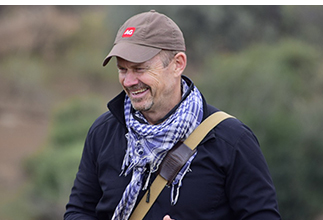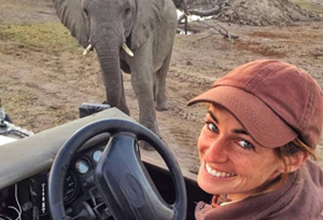
Photographer of the Year 2019 entrant
This is a copy of our weekly email newsletter. Subscribe here to receive the newsletter.
Safari myths busted + Maasai, maize & mammoths

There is a pack of free-roaming wild dogs (African painted wolves) in peril, and you can help. One of South Africa’s largest free-roaming packs (19 members in October) is dependent on communal efforts amongst local landowners as they roam an estimated 65,000-ha near South Africa’s border with Botswana. Now, a core property in this range is for sale, and local conservationists need help finding a wild dog-friendly farmer/owner. The asking price for the 1,855-ha Waterberg farm is R10,5m (about $620,000). For further info, please get in touch with the project coordinator of the Waterberg Wild Dog Initiative. Please flip through your network for potential buyers and send this newsletter to them. The more of a wave we can create here, the better the chance someone will step in to help. And go!
Meanwhile, here in Hoedspruit on the border of the Greater Kruger, the big summer rains have not arrived. Yet. Late last year, I noticed that the hairy rock fig tree in our garden had not flowered up as usual and mentioned my foreboding to Lizz at the time. And, of course, now there is no sign of fruit. Scouting green pigeons and black-collared barbets have arrived and left in a huff. February is usually our wettest month, so here’s hoping for a late rain season of note.
Keep the passion

Simon Espley – CEO, Africa Geographic
 TRAVEL DESK UPDATES:
TRAVEL DESK UPDATES:
We’ve got something for everyone this week – safari aficionados, green travellers, city slickers and seekers of the Big 5:
Affordable South Luangwa safari – expert guide – 5 days – From US$2,460pps
This fantastic combo of walking and driving will appeal to experienced safari-goers and first-timers alike. Expect exceptional game viewing and tracking on foot, scrumptious bush breakfasts and unforgettable sundowners. Did we mention leopards?
Bush & beach, Pinotage to predators – South Africa – 12 days – From US$3,895pps
JUST DO IT! For the pursuit of culinary delights and Big 5 safari heaven, there is this iconic bush and beach safari – with exceptional Greater Kruger Big-5 game viewing, and a taste of sophisticated Cape Town and its surrounding winelands. You know you want to!
From our Editor – Taryn van Jaarsveld

This week we have a challenge for you: how does your awareness of the African wilderness fair against the knowledge of our experts? In our first story below, Jamie busts seven commonly misconstrued safari myths. Having sorted the fact from fiction, we want to hear from you! How many of these safari myths caught you out, and how many did you already know?
Over the past year, we’ve closely observed the challenges facing the continent’s last remaining large tuskers that call Kenya’s Amboseli-Tsavo ecosystem home. We’ve watched closely as three iconic tuskers fell: Dida and Lugard from natural causes, and Tolstoy from complications arising from a spear wound. The work of organisations like Big Life Foundation (BLF) and Tsavo Trust is critical to the long-term coexistence between people and elephants in the area. In our second story, BLF’s Josh Clay has penned a colourful narrative on the day-to-day operations of rangers alleviating human-wildlife conflict between crop-raiding elephants and communities.

Story 1
https://africageographic.com/stories/seven-safari-myths-busted/
SAFARI MYTHS
Can you separate fact from fiction when it comes to the tall tales told about Africa’s wildlife? Our experts bust common safari myths
Story 2
https://africageographic.com/stories/maasai-maize-and-mammoths/
MAASAI, MAIZE & MAMMOTHS
Averting crop-raiding elephants in the Amboseli ecosystem is a constant battle. Josh Clay reports on how rangers prevent human-elephant conflict
From our Scientific Editor – Jamie Paterson

When I put together our first story of the week, I was thrilled to have the opportunity to offload some of my favourite facts that were too lengthy for my newsletter comment. (Do rhinos have bad eyesight? Are male lions part of the pride? You’ll have to read the story to find out.)
But there were a few misconceptions that didn’t make the cut.
For example, anyone who has spent time watching guineafowl (or driving slowly behind them) would be inclined to cast serious aspersions upon their IQ levels. They have tiny brains relative to other birds, and the consensus is that they are, to put it delicately, about as sharp as a marble. And yet, did you know that recent research shows that vulturine guineafowls live in complex, multilevel societies? They even appear to have friends. Fortunately, this does not mean that guineafowls are secretly the Einsteins of the bird world (phew) but that, despite previous beliefs to the contrary, complex social structures don’t necessarily require that much brainpower.

 WATCH: The Matriarchs: Meet Corporal Agnes Sopilal, one of the first female rangers to join Big Life Foundation’s unti-poaching unit. Agnes has devoted her life to working alongside communities in the Amboseli-Tsavo ecosystem to promote the peaceful co-existence of wildlife and people (01:57). Click here to watch
WATCH: The Matriarchs: Meet Corporal Agnes Sopilal, one of the first female rangers to join Big Life Foundation’s unti-poaching unit. Agnes has devoted her life to working alongside communities in the Amboseli-Tsavo ecosystem to promote the peaceful co-existence of wildlife and people (01:57). Click here to watch
To comment on this story: Login (or sign up) to our app here - it's a troll-free safe place 🙂.![]()






